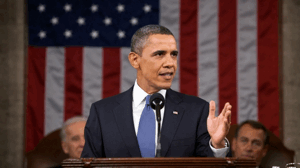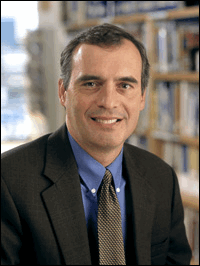State of the Union and Clean Energy
Air Date: Week of January 28, 2011

President Obama delivers his State of the Union address (White House Photo: Pete Souza)
The environment was in the spotlight in President Obama’s State of the Union address. He wants America to get 80 percent of its electricity from clean energy sources in the next 25 years, and to have one million electric vehicles on the road by 2015. Host Steve Curwood is joined by Kevin Knobloch, President of the Union of Concerned Scientists and James Connaughton of Constellation Energy and former chairman of the Council on Environmental Quality under George W. Bush, to discuss whether these goals are attainable.
Transcript
CURWOOD: From the Jennifer and Ted Stanley Studios in Somerville Mass, this is Living on Earth. I'm Steve Curwood.
GELLERMAN: And I’m Bruce Gellerman. He never said the words "environment" or "climate." But at the top of his list were investing in the future and clean energy. President Obama made the pitch in his 2011 State of the Union address and he wants to tap some deep pockets to pay for it:
OBAMA: I’m asking Congress to eliminate the billions in taxpayer dollars we currently give to oil companies. (Audience clapping). I don’t know if you’ve noticed, but they’re doing just fine on their own. So instead of subsidizing yesterday’s energy, let’s invest in tomorrow’s.

President Obama delivers his State of the Union address (White House Photo: Pete Souza)
GELLERMAN: The President outlined ambitious goals for the future, and he wants to start right away:
OBAMA: Tonight, I challenge you to join me in setting a new goal: by 2035, 80% of America’s electricity will come from clean energy sources. (Audience clapping). Some folks want wind and solar. Others want nuclear, clean coal, and natural gas. To meet this goal, we will need them all – and I urge Democrats and Republicans to work together to make it happen.
CURWOOD: Joining me in the studio to discuss President Obama’s address is Kevin Knobloch. He’s President of the Union of Concerned Scientists. Mr. Knobloch, welcome.
KNOBLOCH: Hello Steve.
CURWOOD: Also on the line is James Connaughton. He’s Executive Vice President of Corporate Affairs for Constellation Energy and for eight years headed the Council on Environmental Quality for President George W. Bush, hello, Sir.
CONNAUGTON: Hello, good to talk to you again.
CURWOOD: The President’s goal of 80% clean energy by 2035 struck me as, well, a very bold vision for the future of our energy make up. Jim Connaughton, how did it strike you?

Jim Connaughton is the Vice President of Corporate Affairs and Public Environmental Policy at Constellation Energy. (Constellation Energy ©)
CONNAUGHTON: I liked it and I thought it was hitting some of the themes that should be responsive over time to Republicans. I’d liked it for its ambition, but also because it is reasonably ambitious. I’m at Constellation Energy - our fleet is already at or on its way to meeting the goal today. So we know it can be done. The challenge of the goal is to create a policy environment where it could be done cost effectively.
I also think that’s possible, and that’s where I think the themes matter. Basically, President Obama adopted the all-of-the-above commentary that was really dominant in Republican circles. So, he’s reaching out, he’s sending out common ground signals, you know, can we take the time necessary for folks to find the common ground - that’s the open question. I’m hopeful.
CURWOOD: Kevin Knobloch, what about this all-of-the-above approach? First, what about the vision, and this vision includes things like coal and nuclear that you have questions about.
KNOBLOCH: Steve, I thought it was, it may have been the single most presidential moment in the speech. I mean, this is what Presidents do, they point the prow of the nation into the future, and he planted that flag out there very boldly. He also kind of laid down the gauntlet a bit for the Congress to say, ‘you may be a constituent for carbon capture and storage, for nuclear, natural gas, renewables - you need to be at the table and help us get there.’
It was all-of-the-above, with one very important exception - coal. In terms of burning coal as we traditionally would. Coal is such a harmful fuel. Between respiratory disease, mercury poisoning, mountaintop removal and global warming - soot, smog and so on - it is a very costly fuel. We don’t think of it that way because those costs are not captured, typically, the cost of burning that lump of coal. That said, we rely on coal for 50 percent of our electricity nationally - it’s not going to turn off tomorrow - the cleaner we can get it, the better.
CURWOOD: Jim Connaughton, what about clean coal?
CONNAUGHTON: Coal, today, now, can be very clean from the perspective of cutting the air pollution that people typically associate with ozone, or with acid rain, or the type of air pollution that harms asthmatics. Carbon dioxide, though, those controls actually increase the carbon dioxide emissions because it takes energy to run the pollution control equipment, ironically enough.
And so, I think the idea of a clean electricity standard would be to create the signal that if you can meet this standard - coal, you’re still in! And I think that’s the opportunity the President’s, you know, sort of open-ended invitation created, and I think that’s the right way to do it.
CURWOOD: So, here’s a question, how do you get to 80 percent clean energy in the next 25 years without a cap-and-trade program to price carbon and to send the market signals?
CONNAUGHTON: This is Jim Connaughton. There are actually many different ways to achieve a market-based policy outcome. Cap and trade is one of them. It’s one that I personally prefer, if it’s done right, prior proposals were not very well done. On the other hand, a clean electricity standard is also a market-based approach, incentives are also a market based approaches, as are carbon taxes, or emissions taxes. So, there are many different ways to use a market-based approach that would be consistent even with conservative regulatory philosophy. And so I think the clean electricity standard is a pretty good other way of doing it.
CURWOOD: So, Kevin Knobloch, how do we get to this 80 percent clean energy portfolio without a cap and trade program?
KNOBLOCH: This clean energy program, it’s built on the enormous success of the 30 states that have adopted and implemented state renewable electricity standards. And half of those states have gone back and increased their percentages because they were on such a strong track. There’s a lot of renewables, there’s a lot of clean energy in the pipelines that’s gonna come online in the years ahead.

Kevin Knobloch is President of the Union of Concerned Scientists (Union of Concerned Scientists)
So, this builds on that. And our analysis shows that we could actually get to 80 percent, if you continue the current levels of nuclear, current levels of hydropower, and continue to use the evolving efficiency of our homes, our businesses, our vehicles and address a lot of renewables. We think we can get there.
CURWOOD: Constellation Energy is a leading advocate for the development of new nuclear plants in the United States. Is it far to say that, Jim Connaughton, and if it is, how do you do that without more subsidies from the federal government, from taxpayers?
CONNAUGHTON: So, we have been a strong proponent of new nuclear, and we’re one of four companies that are ready to go ahead and build one of these new plants. We ran into a policy brick wall, if you will, having to do with how the Energy Bill of 2005 was implemented when it came to loan guarantees.
And so the sector doesn’t need subsidies in the sense that you need to appropriate tax-payer dollars and just give it to the sector, what the sector actually needs is just a back stop. Because these plants are so big and take so long to build, you know, these plants are about ten billion dollars or more each; none of us is big enough to carry it on our balance sheet. And so we need the government to help provide a guarantee to help get the thing built.
CURWOOD: Kevin Knobloch?
KNOBLOCH: Well certainly the problem of global warming is so overwhelming and proceeding at such an alarming pace, that if the nuclear industry truly could step up and pick up a big share of the greenhouse gas reductions, and do it in a safe and cost effective way, I think you would see a lot of support. You know, the real trick here is that this is a heavily subsidized industry by the American people.
The legacy subsidies, it was basically built on the back of public subsidies, and now the industry is back at the table asking for a new round of subsidies. You know, we have to find a formula here where the nuclear industry can, in fact, as I say, pick up a bigger share of the clean energy load, but in a way that’s sustainable, in a way that is a business plan that Wall Street would actually get excited about and invest in.
CURWOOD: So in the President’s State of the Union address, I didn’t hear the word ‘climate,’ I didn’t hear the word ‘environment.’ Last year he mentioned the climate bill once, and climate change, twice. What’s going on here - Jim Connaughton?
CONNAUGHTON: Well, it’s interesting you ask that, because I pulled up some of President Bush’s State of the Unions, and in his last State of the Union where he called for the big transportation mandates, the fuel economy standards, the renewable fuel standards - he explicitly did mention climate change, and so, people should look to what President Bush put in the State of the Union. I would not be overly critical of President Obama for leaving it out - I hope and believe he was creating an opening, that we had such a fixation on carbon, which, by the way, is important - but we’ve had a fixation on it to the exclusion of other important goals, such as improved air quality and public health, and energy security. It’s just good old-fashioned innovation and competitiveness.
So, I’d like to imagine that he was trying to create an opening to say ‘look, I don’t need to sell you on fully buying into the climate agenda if you’ll join me in buying into the clean air, the energy security and the competitiveness agenda, or any mix of those.’ And, by the way, that’s where the conversation needs to be anyway.
CURWOOD: Kevin Knobloch, we didn’t hear 'climate' or 'environment' this time.
KNOBLOCH: Well, I appreciate the nuance that Jim is drawing, but it was quite disappointing that the President did not talk about climate change. What we’ve seen over the last couple years, as we tried to legislate on this issue was a very cynical attack on climate science and on scientists, coming out of the fossil fuel industry, coming out of the U.S. Chamber of Commerce, the U.S. Petroleum Institute and elsewhere, and I feel it’s important that the President help the American people understand how robust the body of climate science is, what the environmental, human health and security implications are for this country, and economic considerations. And there’s a story to be told there.
CURWOOD: Of course, a big theme of the State of the Union address was the economy. And to cut the deficit, the President suggested that we freeze annual federal spending for the next five years. So how do we achieve the goals that we’ve talked about, the innovation, the expansion of renewable and clean forms of energy, electric cars, all that sort of thing, AND keep federal spending flat? Kevin Knobloch?
KNOBLOCH: There are a lot of resources at the federal level in play, and simply adding the dollars doesn’t always result in full benefit. So by actually freezing domestic spending, it does put pressure on those existing dollars to be more effective, to do more work. And so the President himself said, let's shift oil and gas subsidy money over to our cleaner energy technologies, I think that’s smart, and then the other way to do it is through performance standards, through renewable electricity standards where you - there’s no taxpayer dollars in play, but you’re requiring companies to step it up and in the case of renewable standards, that then is a game plan, a map for investors to come into a space and invest in renewables because they know there will be a market.
CONNAUGHTON: This is Jim. During the Bush administration, the annual spending in terms of incentives and subsidies in the energy, clean energy, space, rose to a level of greater than 40 billion dollars over eight years. President Obama has already doubled down on that, to his credit, I think that was great, and so you’re working with a pretty big pot, so, already, even with the freeze.
So what I would do, and I think a real bold innovation by the President, would be to take all of the existing pot of subsidies and put them altogether, and then redistribute them on a performance basis based on an emissions profile, and then I would add in the energy profile - you know, the higher energy content you get a higher amount of subsidy, and create a good old fashioned competition.
And clearly that, by the way, would move oil to the bottom of the list, but it would lead them in to innovate, if they could find a way to change their profile. So I think that that would be a huge thing and you get much more bang for the same amount of buck - and the bucks are big!
CURWOOD: It’s time now to give the President of the United States a grade for his State of the Union address in connection with the environment and energy. Kevin Knobloch, how would you score him?
KNOBLOCH: I would give him a B+ or an A- with the debit coming from his omission of discussing global warming in a direct way with the American people.
CURWOOD: Jim Connaughton?
CONNAUGHTON: Well, I’m going to reserve my grade and give him an incomplete, because what I want to grade is the actual legislative proposal.
CURWOOD: Kevin Knobloch is president of the Union of Concerned Scientists, and James Connaughton is vice president of executive affairs for Constellation Energy. Thank you both so much.
KNOBLOCH: Thank you, Steve.
CONNAUGHTON: Thank you.
Links
Living on Earth wants to hear from you!
Living on Earth
62 Calef Highway, Suite 212
Lee, NH 03861
Telephone: 617-287-4121
E-mail: comments@loe.org
Newsletter [Click here]
Donate to Living on Earth!
Living on Earth is an independent media program and relies entirely on contributions from listeners and institutions supporting public service. Please donate now to preserve an independent environmental voice.
NewsletterLiving on Earth offers a weekly delivery of the show's rundown to your mailbox. Sign up for our newsletter today!
 Sailors For The Sea: Be the change you want to sea.
Sailors For The Sea: Be the change you want to sea.
 The Grantham Foundation for the Protection of the Environment: Committed to protecting and improving the health of the global environment.
The Grantham Foundation for the Protection of the Environment: Committed to protecting and improving the health of the global environment.
 Contribute to Living on Earth and receive, as our gift to you, an archival print of one of Mark Seth Lender's extraordinary wildlife photographs. Follow the link to see Mark's current collection of photographs.
Contribute to Living on Earth and receive, as our gift to you, an archival print of one of Mark Seth Lender's extraordinary wildlife photographs. Follow the link to see Mark's current collection of photographs.
 Buy a signed copy of Mark Seth Lender's book Smeagull the Seagull & support Living on Earth
Buy a signed copy of Mark Seth Lender's book Smeagull the Seagull & support Living on Earth

